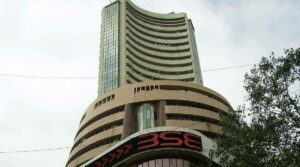Introduction
Stock market indices are a set of stocks that represent the entire market. There are three types of stock market indices- benchmark, sectoral, and market-cap based.
The stock market is an organized market for trading securities, which helps companies raise funds and acts as an investment intermediary for investors. Most of the trading in India takes place on the benchmark indices- BSE and NSE. Both the exchanges follow the same market hours, trading mechanism, settlement process, etc.
India has 23 stock exchanges, including regional exchanges. London Stock Exchange is the oldest stock exchange in the world, whereas the Bombay Stock Exchange (BSE) is the oldest in India.
SEBI has recognized nine stock exchanges in India:
- Bombay Stock Exchange Ltd (BSE)
- Calcutta Stock Exchange
- India International Exchange (Ind INX)
- Indian Commodity Exchange
- Metropolitan Stock Exchange of India
- Multi Commodity Exchange of India
- National Commodity & Derivatives Exchange Ltd
- National Stock Exchange Ltd (NSE)
- NSE IFSC Ltd– a new international stock exchange in the GIFT City, a special economic zone in Gujarat. It will help Indian investors to invest in foreign stocks.


Importance of Stock Market Indices
- Firstly, Stock Market Indices act as a barometer for market behaviour. It represents the movements of all the stocks, which indicate the overall market behaviour.
- Secondly, they are a benchmark to judge a portfolio’s performance. For instance, if individual portfolio returns were 55% but Nifty 50 gave 70% returns, the portfolio has underperformed.
- Thirdly, they help in better resource allocation in companies.
- Further, they help predict the future movement of stock prices and business cycles.
- Then, they act as underlying assets for derivative instruments.
- Lastly, they are used in passive fund management.

Types of Stock Market Indices
There are three types of stock market Indices in India:
- Benchmark Indices- CNX NIFTY and BSE SENSEX are the benchmark indices of the Indian stock market. Both indices show the market performance. For instance, if one says that NIFTY crashed, it shows that the overall Indian stock market has underperformed.
- Sectoral Indices- Some indices represent a particular sector of the economy. For example, S&P BSE Healthcare represents all the listed pharma companies in India. Further, for example, the NIFTY Bank index shows the overall performance of the banks in India.
- Market-cap based indices- They are indices based on the market cap of stocks. Market capitalization shows the value of a particular stock. It is the product of the company’s outstanding shares floating in the market and the current market price. The method to compute market capitalization is known as Free Float Market Capitalization Weighted. The stocks in the index keep on changing as the market cap fluctuates according to the share price. There are three types of stocks based on market capitalization- large-cap stocks (market cap is more than 20,000 crores), mid-cap stocks (market cap is between 5,000-20,000 crores), and small-cap stocks (market cap is less than 5,000 crores). For instance, S&P BSE Large-cap has all the large-cap stocks listed on BSE. Another example is NSE small cap 50 has the top fifty small-cap listed companies.


Types of stock market indices of BSE
Given below are some popular BSE indices:
SENSEX
Bombay Stock Exchange Sensitive Index or BSE SENSEX comprises thirty stocks as per their market capitalization. These stocks are the most active stocks traded on BSE from various sectors. At regular intervals, the stock exchange reviews the index and modifies the composition in such a manner that they reflect the appropriate market conditions. It uses the Free-Float Market Capitalization Weighted method for market cap computation. Free Float means outstanding shares readily available for trading, excluding restricted stocks like employee and promoter shares.
BSE National Index
It comprises the equity shares of 100 companies based on market capitalization. The unique feature of the index is – that it includes prices of the companies listed on regional exchanges like Calcutta, Madras, Delhi, etc. Moreover, the weighted average price of all the scrips indicates the index value. Also, it includes scrips from specified and non-specified groups.
*Scrip is the substitute for legal tender. Here it refers to stocks or shares of a company.
BSE 200
It includes equity shares of 200 companies based on their market capitalization, company fundamentals, and turnover of the company. Moreover, the index shows the weighted average price of all the scrips in the index. Also, it includes scrips from specified and non-specified groups.
Dollex
It is BSE 200 in dollar values, represented in foreign currency. It helps foreign investors to decide on their investments. Hence, the current INR dollar is significant. The forex rates also have an impact on the Dollex index. It includes equity shares of 200 companies based on their market capitalization, company fundamentals, and turnover of the company. Moreover, BSE 200 stocks get modified by dividing the current rupee value with rupee-dollar conversion rates. It also includes scrips from specified and non-specified groups.
BSE 500
It is a standard index which covers all the sectors of the economy and the major capitalization part. It includes equity shares of 500 companies based on their market capitalization, company fundamentals, and turnover of the company. Moreover, the weighted average price of all the scrips indicates the index value.
Types of stock market indices of NSE
Indian Index Services and Products Ltd (IISL) prepares the indices of NSE. IISL is a joint venture of CRISIL and S&P. Hence, NSE is popularly known as CNX NSE. C stands for CRISIL, N stands for NSE, and X stands for index.
Given below are some popular NSE indices:
S&P CNX NIFTY
It comprises the largest equity shares of 50 companies listed on the stock exchange from 23 sectors of the entire economy based on market capitalization. Also, out of the total companies listed on NSE, these 50 companies cover 60% of the total market capitalization. Moreover, the weighted average price of all the scrips indicates the index value.
S&P CNX DIETY
S&P CNX NIFTY represented in dollars is S&P CNX DIETY. A dollar-dominated index is useful for foreign investors. Additionally, S&P CNX NIFTY stocks get modified by dividing the current rupee value with rupee-dollar conversion rates.
CNX NIFTY Junior
Out of all the stocks listed in NSE, the top 100 as per market capitalization form CNX NIFTY 50 and CNX NIFTY Junior. The first 50 stocks form NIFTY 50, and the next 50 forms NIFTY Junior. Moreover, the weighted average price of all the scrips indicates the index value. The two indices operate separately, no two stocks appear on both indices at the same time.
S&P CNX 500 Equity Index
A market capitalization index that comprises 500 stocks listed on BSE and NSE. Additionally, it comprises 79 companies and is 73% of the total market capitalization.
CNX Midcap 200 Index
As the name suggests, the index covers the largest 200 mid-cap companies listed on NSE, having a market cap between 5,000-and 20,000 crores.
CNX segment Index
The index differs from sector to sector. There are different indices for different sectors of the economy. For instance, NIFTY Bank, NIFTY Healthcare, etc.
NSE Government Security Index
The index indicates the price movements of fixed income securities issued by the government like T-bills, government securities, etc. It includes bonds redeemable after 1997.




